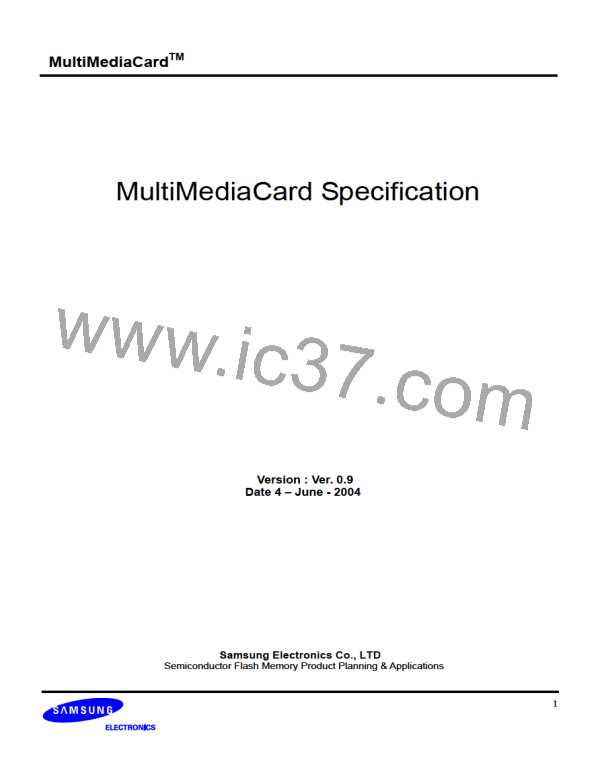MultiMediaCardTM
2 Function Description
2.1 Flash Technology Independence
The 512 byte sector size of the MultiMediaCard is the same as that in an IDE magnetic disk drive. To
write or read a sector (or multiple sectors), the host computer software simply issues a Read or Write
command to the MultiMediaCard. This command contains the address and the number of sectors to
write/read. The host software then waits for the command to complete. The host software does not get
involved in the details of how the flash memory is erased, programmed or read. This is extremely
important as flash devices are expected to get more and more complex in the future. Because the
MultiMediaCard uses an intelligent on-board controller, the host system software will not require
changing as new flash memory evolves. In other words, systems that support the MultiMediaCard
today will be able to access future MultiMediaCards built with new flash technology without having to
update or change host software.
2.2 Defect and Error Management
MultiMediaCards contain a sophisticated defect and error management system. This system is
analogous to the systems found in magnetic disk drives and in many cases offers enhancements. For
instance, disk drives do not typically perform a read after write to confirm the data is written correctly
because of the performance penalty that would be incurred. MultiMediaCards do a read after write
under margin conditions to verify that the data is written correctly (except in the case of a Write without
Erase Command). In the rare case that a bit is found to be defective, MultiMediaCards replace this bad
bit with a spare bit within the sector header. If necessary, MultiMediaCards will even replace the entire
sector with a spare sector. This is completely transparent to the host and does not consume any user
data space.
The MultiMediaCards soft error rate specification is much better than the magnetic disk drive
specification. In the extremely rare case a read error does occur, MultiMediaCards have innovative
algorithms to recover the data. This is similar to using retries on a disk drive but is much more
sophisticated. The last line of defense is to employ powerful ECC to correct the data. If ECC is used to
recover data, defective bits are replaced with spare bits to ensure they do not cause any future
problems.
These defect and error management systems coupled with the solid-state construction give
MultiMediaCards unparalleled reliability
2.3 Endurance
MultiMediaCards have an endurance specification for each sector of 1,000,000 writes (reading a
logical sector is unlimited). This is far beyond what is needed in nearly all applications of
MultiMediaCards. Even very heavy use of the MultiMediaCard in cellular phones, personal
communicators, pagers and voice recorders will use only a fraction of the total endurance over the
typical device’s five year lifetime. For instance, it would take over 100 years to wear out an area on the
MultiMediaCard on which a files of any size (from 512 bytes to capacity) was rewritten 3 times per hour,
8 hours a day, 365 days per year.
With typical applications the endurance limit is not of any practical concern to the vast majority of users.
2.4 Automatic Sleep Mode
7

 SAMSUNG [ SAMSUNG ]
SAMSUNG [ SAMSUNG ]